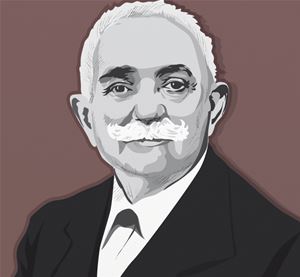The cover of coffee maker Lavazza’s calendar for 2014 features a photo of the Spanish avant-garde chef Ferran Adrià. Seven other of the world’s top chefs also appear in the calendar, striking whimsical poses for German photographer Martin Schoeller. Lavazza’s calendars, which the company has produced every year since 1993 and which feature work by top photographers, are a powerful tool in globally promoting the image of this fourth-generation family company. In fact, today, Lavazza is one of the world’s best-known coffee brands, with four production facilities in Italy, foreign subsidiaries in France, Germany, Spain, the United Kingdom, Portugal, Austria and the United States, and a rapidly growing distribution network throughout 90 countries.
In 1895, Luigi Lavazza opened a small shop specialising in spices, soap, spirits, oil and coffee in the centre of Turin. A native of Murisengo, a small town in the mountains of Monferrato, Lavazza was born on April 24, 1859, into a family of struggling peasant farmers. His father, all too familiar with the precarious nature of life on the land, knew the importance of education and insisted that Luigi finish elementary school before finding a job as a bookkeeper at a local kiln. But after a devastating hailstorm in August 1885, young Luigi Lavazza, like many others from his region, migrated to Turin in search of a more stable occupation. He attended trade school at night and then took a diploma at the municipal chemistry institute. A year after marrying Emilia Morino in 1894 (with whom he would have seven children), he borrowed 10,000 lire from his last employer and invested his own savings to buy the grocery store.

He soon turned the run-down business into a thriving concern by not only selling traditional grocery products but by buying raw coffee through a supplier in Genoa and roasting it himself at the back of the shop. It quickly became the signature product of the business.
His cousin, Pericle Franco, entered the business in 1895, and by 1900 it employed six workers and had a weekly take of the then tidy sum of 4,200 lire. By 1910, success allowed Lavazza to move his enterprise into bigger premises close by the first shop. At that time, coffee sales tracked on the harvest of each type of bean, which meant that profits were affected by seasonal fluctuations. To address this problem, Lavazza personally began experimenting, blending different mixtures of coffee roasts until he had created a smooth blend. It immediately proved popular and profitable.
Although just before World War I, the company had grown to employ 40 workers, many were drafted into the Italian army when the war began. Lavazza coped: he put his entire family to work for him. As raw materials and foodstuffs also became scarce, he limited his trade to certain products and foodstuffs, mostly oil, sugar and roasted coffee. That move saved the company. By 1923, the Lavazza company was Italy’s leading coffee manufacturer.
Luigi Lavazza’s next move was to introduce cutting-edge technology into the process—still a priority of the company—employing new machinery to package the coffee so its aroma would be preserved for longer and the product would be easier to transport.
With some of his children now adults and ready to take responsibility within the enterprise, in 1927, Luigi Lavazza created an unregistered company, subdividing the shares among himself, his wife and his three oldest children, Mario, Giuseppe and Maria. The following year, he transformed it into a joint-stock company, Luigi Lavazza spa, with a share capital of 1,500,000 lire. In 1931, he again expanded by upgrading his sales network so that the company’s agents not only took orders but also looked after product delivery and received payments. In 1933, by then in his seventies, Lavazza surrendered all his shares to his children and handed the management over to his sons: Mario (1899–1963) and Giuseppe (1901–1971), and later Pericle (1908–1979).
Luigi Lavazza retired to Murisengo in 1936, but, sadly, lived to see difficult years that almost destroyed his life’s work. In 1935, the League of Nations placed sanctions on Italy, including a blockade on coffee, in response to its invasion of Ethiopia, one of its major sources of supply. Then, there was a total ban imposed on the importation of coffee by Mussolini between 1940 and 1945. The factory in Turin was bombed during World War II. Indeed, the company survived the sanctions and the war on the strength of its sales of oil, soap and candles.
The Lavazza company was finally able to restart coffee production in 1946. To mark the occasion, it created a new logo for its packages. This was one of the earliest examples of brand marketing in Italy, a priority that still distinguishes the company’s strategy today, as demonstrated by its calendar and imaginative advertising campaigns.
On August 6, 1949, Luigi Lavazza died, aged 89, in Murisengo, leaving behind a tradition that future generations of his family have continued to uphold: making his name synonymous, nationally and internationally, with a great cup of java.







